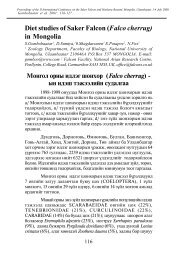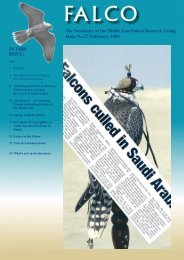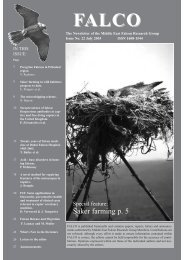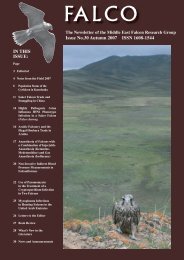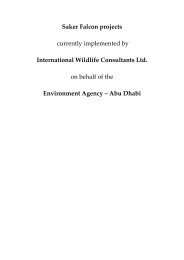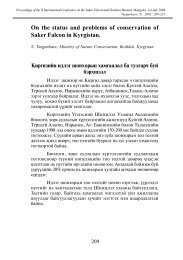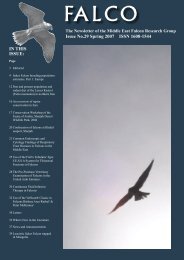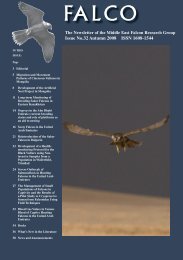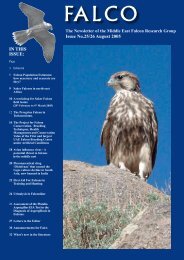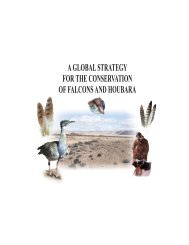25Eastham, C.P., Nicholls M.K. and Fox, N.C. (2002)Morphological Variation of the Saker (Falco cherrug)and the implications for conservation. Biodiversityand Conservation 11: 305-325.This study assesses the external morphology of the sakerwhich is highly variable. Although most variation wasbetween individuals within regions, the remaining variationin size and plumage characters may be described asa gradual cline between small, dorsally uniform brownsakers from western lowland regions (Kazakhstan andsouth west Russia) to large grey coloured sakers fromeastern highland regions (south east Russia, Mongoliaand China). Between these extremes exists a plethora ofhighly variable and contiguous populations.Krone, O., Priemer, J., Streich, J., Sommer, P.,Langgemach, T., Lessow, O. (2001) Haemosporidaof birds of prey and owls from Germany. ActaProtozoologica 40, No.4, pp.281-2891149 free-living birds of prey from Germany were examinedfor blood parasites. The prevalence of infection was11% (adult birds 18%, immature birds 16%, and nestlings4%). Among the Falconiformes and Strigiformes,11% of 976 and 13% of 173 birds, respectively, wereinfected. Of 17 <strong>falco</strong>niform species, 9 were infected withblood parasites whereas the Eurasian buzzard (Buteobuteo) had the highest prevalence for haematozoa; i.e.Leucocytozoon toddi (31%), the highest prevalence(25%) for Haemoproteus sp. was found in the hobby(Falco subbuteo). Eight species of owls were examinedfor blood parasites; the tawny owl (Strix aluco) had thehighest prevalence with Haemoproteus syrnii (22%).In one pygmy owl (Glaucidium passerinum) examined,Trypanosoma avium and Plasmodium fallax weredetected. The white-tailed sea eagle (Haliaeetus albicilla)was found to be a host of L. toddi for the first time.Differences in the prevalence of blood parasites werefound in the seasons and age classes of the birds.Lierz, M., Gobel, T., Schuster, R. (2002) Review andinvestigations on parasites in birds of prey and owlsfound injured or debilitated. Berliner und MunchenerTierarztliche Wochenschrift 115, No.1/2, pp.43-52In the present paper, a general overview on parasites inbirds of prey and owls is given. This part is followedby a study investigating the prevalences and species ofparasites in free- ranging birds of prey and owls in Berlinand Brandenburg State, Germany. In a period of oneyear (between August 15, 1996 and August 15, 1997),84 birds of prey and owls of the following species wereexamined for the presence of endo- and ectoparasites:Common Buzzard (Buteo buteo; n=32), Kestrel (Falcotinnunculus; n=20), Sparrowhawk (Accipiter nisus; n=9),Goshawk (Accipiter gentilis; n=8), Black Kite (Milvusmigrans; n=4), Peregrine Falcon (Falco peregrinus; n=3),Marsh Harrier (Circus aeruginosus; n=1), White-tailed-Sea Eagle (Haliaeetus albicilla; n=1), Tawny Owl (Strixaluco; n=4), Long-eared Owl (Asio otus; n=1) and BarnOwl (Tyto alba; n=1). In 97.6% of the cases, ectoparasites(feather mites and hippoboscid flies) were found.It was observed that 93.3% of eyasses were positive forhippoboscid flies. Trichomonas was detected in 28.6%of all birds of prey and owls examined. A prevalence of100% was established in the Sparrow Hawks as well asPeregrine Falcons. Leucozytozoon sp. and Haemoproteussp. as blood parasites were found in 26.9% of the birdsin total. Common Buzzards showed the highest prevalence(44.8%). A total of 58.3% of birds examinedwere positive for endoparasites. Flukes were found in16.7%, tapeworms in 14.3%, roundworms in 48.8%and acanthocephales in 2.4% of the cases. Interestingly,Tylodelphis clavata (in a Common Buzzard) andHovorkonema variegatum (in a Goshawk) were found forthe first time in raptors. The results of this study underlinethe importance of a parasitological examination inthe process of raptor rehabilitation.Manvell, R. J., McKinney, P., Wernery, U., Frost, K.(2000) Isolation of a highly pathogenic influenza Avirus of subtype H7N3 from a peregrine <strong>falco</strong>n (Falcoperegrinus). Avian Pathology 29, No.6, pp.635-637A peregrine <strong>falco</strong>n (Falco peregrinus) was presented tothe Al Safa Falcon Clinic in Dubai, United Arab Emiratesunable to stand [date not given]. Four hours after hospitalization,the bird died despite supportive care andcalcium disodiumedetate treatment. The <strong>falco</strong>n had beenon a hunting trip to Syria with its owner of 2 years, priorto its death. The carcass was submitted to the CentralVeterinary Research Laboratory in Dubai where it wassubjected to postmortem examination. Investigationsresulted in the isolation of an influenza A virus subtypeH7N3, which proved to be highly pathogenic for chickens.Parga, M. L., Pendl, H., Forbes, N. A. (2001) The effectof transport on hematologic parameters in trained anduntrained Harris’s hawks (Parabuteo unicinctus) andperegrine <strong>falco</strong>ns (Falco peregrinus). Journal of AvianMedicine and Surgery 115, No.3, pp.162-169Birds of prey are found increasingly in captive situations.When sick, these animals show only very subtle signs ofdisease, making the detection of disease difficult. For thisreason, the analysis of haematological parameters is avery useful technique for the avian veterinarian. However,birds are most frequently transported to the veterinaryclinic for a health check-up. This study investigates theeffects of transport-related stress on heterophil and lymphocytemorphology and haematological parameters ofperegrine <strong>falco</strong>ns (Falco peregrinus) and Harris’s hawks(Parabuteo unicinctus). Twelve birds of each speciesfrom the UK, all adults, mixed males and females, wereanalysed. Each group of 12 was comprised of 6 trained(accustomed to being transported) and 6 untrained birds.Samples of blood were taken from all birds in their placeof origin and again 1 week later after 1 hour (35 km) oftransport. Both samples were taken in similar conditions(eg, time of day, duration after feeding, environmentaltemperature, sample handling) so that any variationwould be caused only by transport-related factors. Bothuntrained groups showed a significant (P
untrained peregrines showed no other significant change,untrained Harris’s hawks had a significant leukopenialymphopaenia and eosinopaenia. Trained Harris’s hawksshowed a significant monocytosis, whereas trained peregrinesshowed no significant change. Transport had noapparent influence on heterophil or lymphocyte morphology.Although the difference between pre- and posttransportwas significant in some parameters, all values in the4 groups remained within the reference ranges for thespecies. Therefore, we can conclude that 1-hour transportfor trained or untrained members of these 2 species toa clinic need not be factor that requires the clinician’sconsideration when interpreting a haematological sample.However, the 2 species reacted differently to transport.Further studies on other species are suggested. The H/Lratio is proposed as the most sensitive measure of stressresponse in the blood picture of raptors and possible usesare suggested.Samour, J. H., Naldo, J. L., John, S. K. (2001) Stainingcharacteristics of the eosinophil in the saker <strong>falco</strong>n.Exotic DVM 3, No.4, p.10The differentiation of eosinophils is one of the most difficulttasks encountered during hematology analysis inavian species, but in particular in birds of prey.1 In addition,the eosinophils and heterophils share many morphologicalcharacteristics2-6 making differentiation betweenthem challenging.5-7 These difficulties can be overcomeby the adequate staining of these cells and by becomingaware of the relevant differences of the normal morphologyof heterophils and eosinophils in the different avianspecies. During routine hematology analysis of samplesfrom saker <strong>falco</strong>ns it was found that the stainingof granules of eosinophils using May GrünwaldGiemsa stain was not satisfactory. After some trialsinvolving different stains, timings, concentrationsand buffers, the best results were obtained using amodified Wright’s-Giemsa stain. The modificationto the Wright’s-Giemsa stain consisted of adding5.0ml of glycerol and including step number fourto the staining procedure. Diff-Quick or similarstains are not recommended for routine hematologyanalysis because these techniques tend to rupturethe granules of the granulocytes. The use of themodified Wright’s-Giemsa stain as described canprobably be applied to other avian species in whichcell differentiation has proved difficult.<strong>falco</strong>n died 9 days after the challenge, with typical lesionsof herpesvirus inclusion body hepatitis. The 3 vaccinated<strong>falco</strong>ns seroconverted and did not show any symptoms.Following the challenge, their antibody titres to <strong>falco</strong>nherpesvirus increased. No herpesvirus was isolated fromany of the cloacal swabs taken during this experiment,indicating that there was no danger for any other birdsfrom DuFaHe. This experiment shows that <strong>falco</strong>ns canbe protected from herpesvirus infection by an attenuatedherpesvirus vaccine. However, it should be stressed thatonly 4 <strong>falco</strong>ns were used for this experiment.Conference announcement6th World Conferenceon Birds of Prey and OwlsBudapestHUNGARY18-25 May 2003Deadline for abstract submissions 1 March 2003For further information contact:World Working Group on Birds of PreyP.O. Box 52, Towcester, NN12 7ZW, EnglandTel/Fax +44 1604 862331Email: WWGBP@aol.com or robin.chancellor@virgin.netWernery, U., Joseph, S., Kinne, J. (2001) Anattenuated herpes vaccine may protect Gyrhybrids from fatal inclusion body hepatitis.A preliminary report. Journal of VeterinaryMedicine. Series B, 48, No.10, pp.727-732Four Gyr<strong>falco</strong>n hybrids were used for this <strong>falco</strong>nherpes vaccine trial. Three <strong>falco</strong>ns were given 1ml of an attenuated <strong>falco</strong>n herpesvirus vaccine(DuFaHe) subcutaneously twice within 14 days,whereas the fourth <strong>falco</strong>n was used as a control. 18days after the booster vaccination, all 4 Gyr hybridswereintranasally and ocularly challenged with a virulentlow- passage <strong>falco</strong>n herpesvirus. The controlGyr/Saker26



